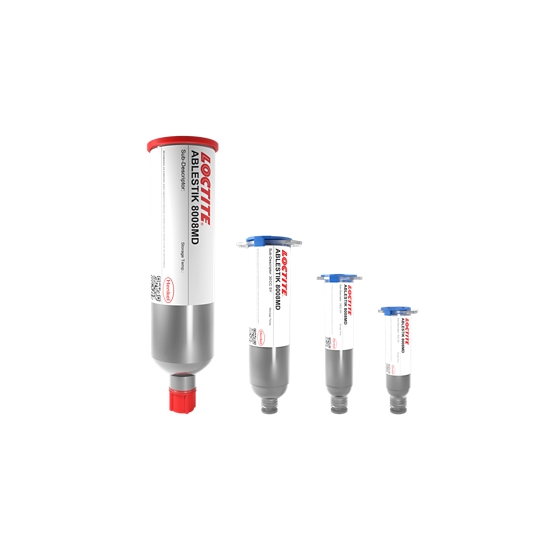Loctite Ablestik 8008MD
- Thermally conductive
- Electrically conductive
- Stencil printing
Product Description
LOCTITE ABLESTIK 8008MD adhesive is designed for medium die attach applications. This thermally and electrically conductive proprietary hybrid product can be applied to a wafer backside by stencil printing and then B-staged in an oven.
LOCTITE ABLESTIK 8008MD can then be cured after die attach in an in-line process. This material has good substrate wetting, controlled bondline thickness was originally known as RP-825-3C1. It is typically used on PPF, Copper and Silver plated CU leadframes.
LOCTITE ABLESTIK 8008MD is designed as a Wafer Back side Coating for die sizes down to 150x150um and should be applied to the wafer and dried before dicing. The solvent in 8800MD should evaporate before die placement or during slow cure ramp up. Also, Instead of printing the whole wafer, we expect that 8008MD is also suitable for printing smaller dots.
Cure Schedule
- 30 minute ramp to 175°C + 60 minutes @ 175°C
Technical Specifications
| General Properties | |
| Work life @25°C Work life @25°C Work life is the amount of time we have to work with a material until it is no longer able to be easily worked and applied on a substrate. It is based on the change in viscosity and it can rely on the application requirements. | 24 hours |
| Thermal Properties | |
| Thermal Conductivity Thermal Conductivity Thermal conductivity describes the ability of a material to conduct heat. It is required by power packages in order to dissipate heat and maintain stable electrical performance. Thermal conductivity units are [W/(m K)] in the SI system and [Btu/(hr ft °F)] in the Imperial system. | 6 W/m.K |
| Electrical Properties | |
| Volume Resistivity Volume Resistivity Volume resistivity, also called volume resistance, bulk resistance or bulk resistivity is a thickness dependent measurement of the resistivity of a material perpendicular to the plane of the surface. | 5.0x10-4 Ohms⋅cm |
| Physical Properties | |
| Thixotropic index Thixotropic index Thixotropic Index is a ratio of a material s viscosity at two different speeds in Ambient temperature, generally different by a factor of ten. A thixotropic material s viscosity will decrease as agitation or pressure is increased. It indicates the capability of a material to hold its shape. Mayonnaise is a great example of this. It holds its shape very well, but when a shear stress is applied, the material easily spreads. It helps in choosing a material in accordance to the application, dispense method and viscosity of a material. | 2.6 |
| Viscosity Viscosity Viscosity is a measurement of a fluid’s resistance to flow. Viscosity is commonly measured in centiPoise (cP). One cP is defined as the viscosity of water and all other viscosities are derived from this base. MPa is another common unit with a 1:1 conversion to cP. A product like honey would have a much higher viscosity -around 10,000 cPs- compared to water. As a result, honey would flow much slower out of a tipped glass than water would. The viscosity of a material can be decreased with an increase in temperature in order to better suit an application | 67,500 mPa.s |



